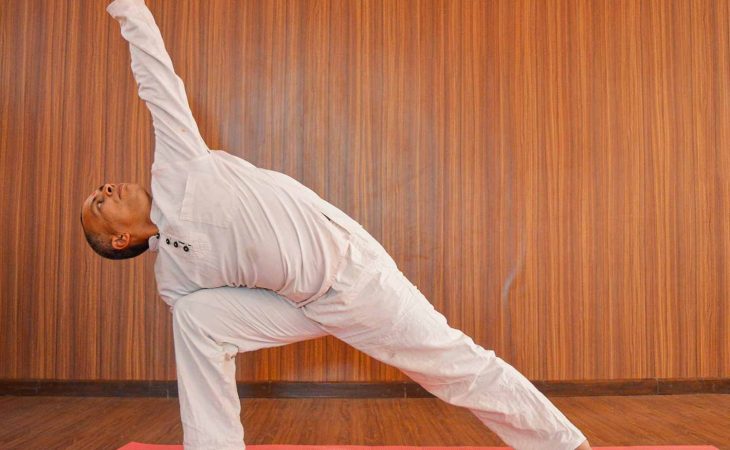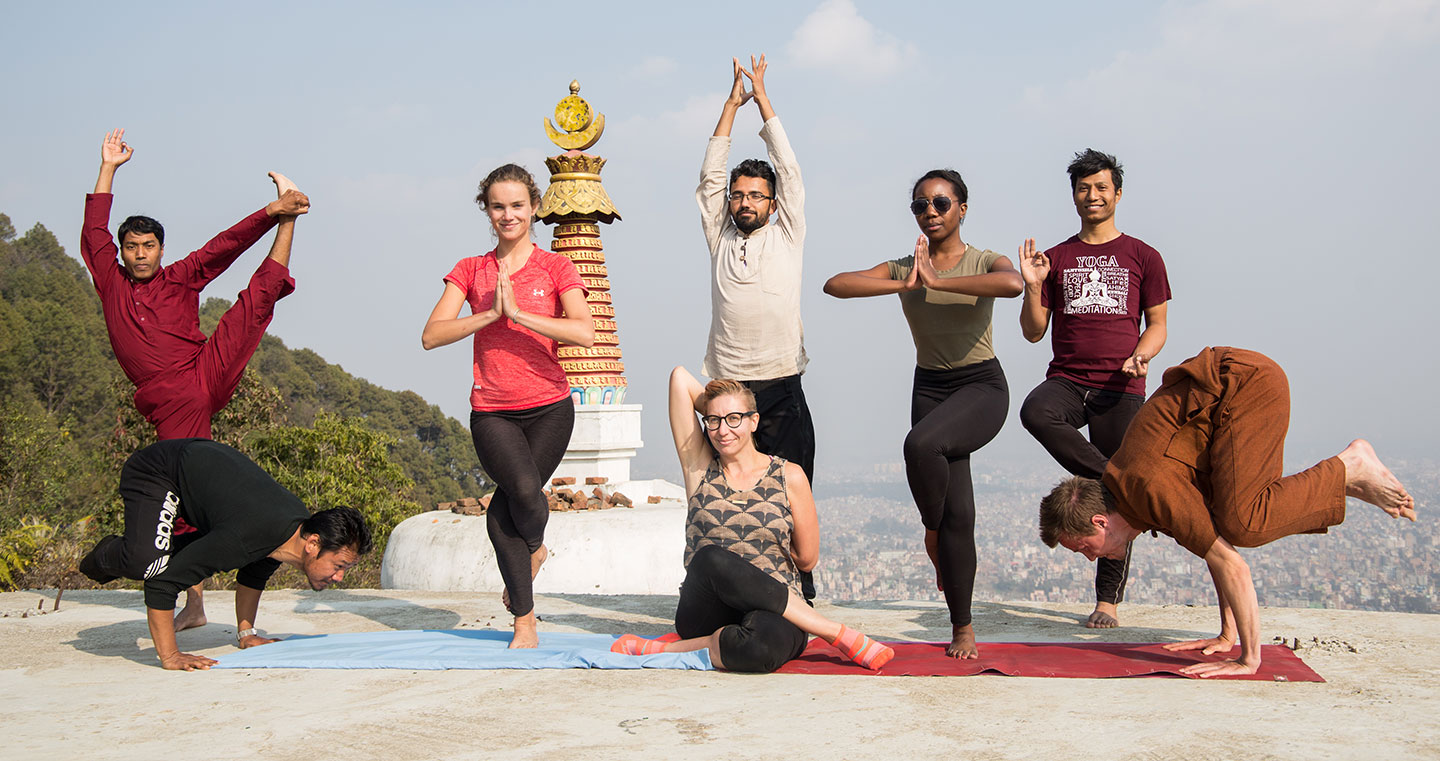Ashtanga Vinyasa Yoga is a style of yoga as exercise created by K. Pattabhi Jois during the 20th century, often promoted as a modern-day form of classical Indian yoga.[1] He claimed to have learnt the system from his teacher, Tirumalai Krishnamacharya. The style is energetic, synchronizing breath with movements. The individual poses (asanas) are linked by flowing movements (vinyasas).More about Ashtanga Vinyasa Retreat in Nepal
Usually an Ashtanga Vinyasa practice of asanas begin with five repetitions of Surya Namaskara A and five repetitions of Surya Namaskara B, followed by a standing sequence.[7] Following this the practitioner progresses through one of six series, followed by a standard closing sequence.[7]
The six series but most popular series are :
- The Primary series: Yoga Chikitsa, Yoga for Health or Yoga Therapy[8]
- The Intermediate series: Nadi Shodhana, The Nerve Purifier (also called the Second series)
- The Advanced series: Sthira Bhaga, Centering of Strength
What Are 3 Principles of Ashtanga Yoga?
The practice of ashtanga yoga is rooted in the concept of tristhana, which encourages ashtanga practitioners to focus on introspection, making the practice a form of moving meditation. The three pillars of tristhana are:
Pranayama: Ashtanga Vinyasa yoga uses the breathing method ujayi pranayama, commonly referred to as “ocean breath,” to improve oxygen levels and increase body heat.
Asana: In ashtanga vinyasa yoga, the asanas are performed in a strict order that does not change. Through these asanas, you also activate three primary bandhas, or lock points, in the body. The three bandhas are the mula bandha (located at the base of the spine), the uddiyana bandha (slightly below the belly button), and the jalandhara bandha (near the throat).
Drishti: Dristhi—derived from dharana, or concentration, which is originally outlined as one of the eight limbs of yoga—refers to where you fix your gaze in the practice of yoga. This element of tristhana brings your mind into the practice, improving focus and self-awareness as you breathe and move.
What are the health benefits of Ashtanga Vinyasa Retreat in Nepal?
There are many reasons why people choose to practice Ashtanga Vinyasa - like its effect on both your physical and psychological well-being. Below are some of the most popular health benefits of Ashtanga Vinyasa , including a faster metabolism, better mood, and lowered stress levels.
- It focuses on muscle training and develops physical strength. Practicing Ashtanga rejuvenates your body, making it stronger, toned, more flexible and controlled.
- Ashtanga yoga will keep your body moving in coordination with the breath. Breath awareness is particularly important in this practice
- It improves focus, balance and coordination. A swift and intense set of asanas instills a better sense of rhythm and increases your awareness of the movement and flow of your body.
Why Ashtanga Vinyasa Class with Himalayan Yoga Academy ?
- Experienced Retreat Environment
- Best Ashtanga Vinyasa Teachers
- Best Instructions with Notes.
- Our Teacher Training Course also focuses on Ashtanga Vinyasa
Daily Schedule
Arrival Day
L & D Private / Sharing
Before 02:00 pm – Check In; Room Arrange and Rest
03:30 – 04:30 pm – Rest
05:00 - 05:15 pm – Herbal Tea
5:15 - 06:45 pm – Bhakti Yoga (Prayer/ Chants), Spinal Asana/ Suryanamaskar; Yoga-nidra, Mudra, Dhyana Yoga (Meditation)
07:00 - 07:30 pm – Dinner and Herbal Tea
07:30 - 08:30 pm – Bhakti Yoga (Prayer/Chants),
Trataka (Concentrated Gaze) and Discussion
08:30 – 09:45 pm – Evening walk, Vajrasana, Self-study & Practice
10:00 pm – Bed Time (Lights out)
Main Day ( 2 -6 )
Private / Sharing
06:00 am – Wake up and Ushapan (Early Drinking water)
06:30 - 07:00 am – Jala Neti (Nasal Cleansing) and Herbal Tea
07:00 - 08:45 am – Bhakti Yoga (Prayer/Chants), Warm up exercise, Suryanamaskar,Yogasana, Bandha, Pranayama, Shanty Path (Peace Mantra
09:00 - 10:00 am – Breakfast and Herbal Tea
11:00 - 01:00 pm – Ashtanga Vinyasa Session
01:00 - 02:00 pm – Lunch and Herbal Tea
02:00 - 05:00 pm – Nature/Village/Temple/ Monastery visit, Jungle visit or Self-practice
05:00 - 05:15 pm – Herbal Tea
05:15 - 06:45 pm – Bhakti Yoga (Prayer/Chants), Spinal Asana/ Suryanamaskar;Yoga-nidra, Mudra, Dhyana Yoga (Meditation)
07:00 - 07:30 pm – Dinner and Herbal Tea
07:30 - 08:30 pm – Bhakti Yoga (Prayer/Chants),Trataka (Concentrated Gaze) and Discussion
08:30 – 09:45 pm – Evening walk, Vajrasana, Self-study & Practice
10:00pm – Bed Time (Lights out)
Departure Day
B & L Private / Sharing
06:00 am – Wake up and Ushapan (Early Drinking water)
06:30 - 07:00 am – Jala Neti (Nasal Cleansing) and Herbal Tea
07:00 - 08:45 am– Bhakti Yoga (Prayer/Chants), Warm up exercise, Suryanamaskar, Yogasana, Bandha, Pranayama, Shanty Path (Peace Mantra)
09:00 - 10:00 am – Breakfast and Herbal Tea
10:00 - 01:00 pm – Rest
01:00 - 02:00 pm – Lunch and Herbal Tea
02:00 pm – Check Out
Package Cost
Private Accommodation - USD 500 per person
Sharing Accommodation - USD 400 per person
Note: If you are in Group, ask for special rates


